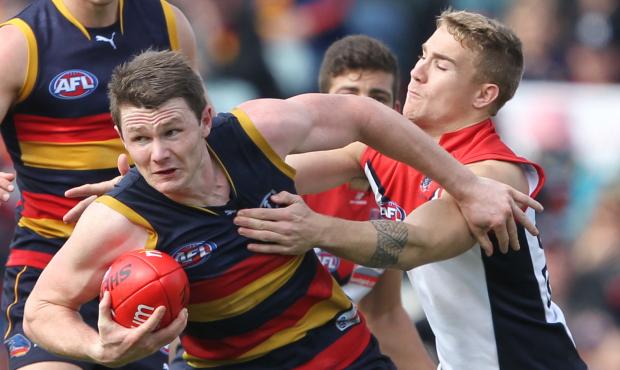Dr Martin Buchheit, an exercise physiologist from the ASPIRE Academy for Sports Excellence in Qatar, spent a week with the Crows at West Lakes and told AFL.com.au he was impressed with what he saw.
Training pressures on AFL players are so great that, several years ago, Buchheit would have questioned most coaches in the League for pushing them too far.
But now he says Australian football is a game like no other, and Dangerfield is like few other athletes he has seen.
"You can't miss 'Danger' – he's covering the full range, he's the fastest and one of the strongest but he's also fit ... on top of that this guy's good with the ball," he said.
"Often athletes have a one-sided profile, whereas the perfect athletes in general are those with the complete profile.
"But then more complete athletes are usually more average in all areas, so he's pretty impressive like that."
Buchheit, who has previously worked with Carlton and several major soccer organisations including French powerhouse Paris Saint Germain, worked primarily with the Crows' sports science staff on interpreting players' training data.
The plan, he says, is to find way to help make in-season training sessions more effective.
"I'm just trying to throw in my five cents and maybe just tweak a few things rather than reinventing everything from the start," he said.
"It's really about improving the training, the analysis and the monitoring.
"Rather than saying, 'I think this player is not good enough today', it's about having scientific evidence to know instead of think."
Adelaide's physical performance manager Nick Poulos said that with such short turnarounds from game day to training, it was vitally important to quickly and accurately interpret data in order to train the players as smartly as possible.
Adelaide superstar Patrick Dangerfield in action for the Crows in round 22. Picture: AFL Media

"Being more accurate with that scientific process allows me to make an objective decision on the training rate of the players – week to week, day to day," Poulos said.
"In-season, you've got 24 hours to make a decision as to what players will do in their first few days of training after a game, so the stuff that goes on behind the scenes and how you analyse data has to be as efficient as possible."
Buchheit also gave the thumbs-up to the Crows' training methods, which resembled a relatively new philosophy known as 'tactical periodisation'.
Using the ideology, which was developed in Portugal and is favoured by Chelsea manager Jose Mourinho, all exercises are designed with a huge importance on sport-specific skills and tactics.
Due to the unique aerobic requirements of Australian football, tactical periodisation isn't always appropriate but Buchheit said it allowed clubs to reduce training loads and also maintain match fitness.
"This is the thing that [Adelaide] is doing pretty well, but I haven't seen that everywhere," he said.
"They are into it at the moment, but it's pretty new.
"This is the strength of what happens now in football, my football - soccer.
"First, drills are technically driven and then made relevant to the conditioning and fitness ... it becomes pretty efficient.
"It's probably why in soccer they don't train that much because they just get what they really need…it's a way to reduce the load."
See you soon mates! Thanks for these great moments @PoulosNick @JarrydWallace7 @Willmorgan4 Bode @Adelaide_FC pic.twitter.com/xjvmCdWk18
— Martin Buchheit (@mart1buch) November 29, 2013

